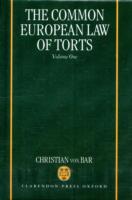This awe-inspiring book is the first of a two volume treatise on the law of non-contractual obligations. The result of a unique attempt to discover the common elements of the law of torts of all the member states of the European Union, it is founded on the belief that the approximation of European laws should not be left to the directives and regulations of Brussels alone. The first task of such a project is to determine to what extent a jus commune europaeum already exists. To this end, von Bar has undertaken a thorough, detailed and extensive analysis of the relevant court rulings and academic writings of all the jurisdictions of the European Union to distill a European common law of torts. The insights gained from the comparative analysis also offer a guidance to greater harmonisation in the future.
The material covered in volume one includes: the areas of application of tort law and its boundaries with contract, property, criminal and constitutional law; the elements of liability under the general clauses of the European civil codes and the more specific torts of the common law. Further topics include: strict liability, liability for other persons, animals and premises; multiple tortfeasors; and an account of European Union and Council of Europe attempts to harmonise the less coherent areas of tort law.
Von Bar's book is destined to become a landmark in the area of comparative law in general, and comparative torts in particular.
From the author's preface
The attempt undertaken here to draw up a system of a common European law of torts is an orthodox treatise on the non-contractual law of obligations. This book displays distinctive features only in so far as its material stems from all the laws of tort within the European Union. It seemed possible to understand and portray each tort law as merely a national manifestation of a single discipline. For, although different legal practices which have each grown naturally in their own environment do occasionally lead to different results, they can be dealt with in the same way as a single legal system in which a lawyer has to find his way through a variety of opinions. The person who looks, not only at his own, but also surrounding laws, broadens the range of possible debate. In writing about different laws he undertakes work fundamentally no different from that on his own legal system, so long as the systems are equal in their basic values, in the quality of their legal method, and have continuously learned from each other. This is the case in the countries of the European Union, and it is therefore possible to condense their different national laws to a common European law of torts (or delict). To try to understand its structures does not mean leaving distinctive features of individual nations out of consideration. Without an understanding of their effectiveness and their elegance, the treasure of judicial knowledge, which distinguishes European private law, will not be appreciated. However, to think in a European fashion firstly means stressing the common characteristics, secondly, learning to understand national laws as reactions to developments in neighbouring countries, and thirdly, tackling historical coincidences and rough edges
European politics is not our primary concern, and the question whether reflections on common European private law can flow into a general law, that is to say into an extensive unification of law in the fashion of a Civil Code, is altogether a cura posterior. The challenge is to identify how the sixteen systems actually function, not how they would function were they united in one system. we are portraying here, not a single national law in comparison with other laws, rather we have chosen from the start a European standpoint; European meaning the states of the European Union
EAN 9780198260561
ISBN 0198260563
Binding Hardback
Publisher Oxford University Press
Publication date December 17, 1998
Pages 808
Language English
Dimensions 242 x 163 x 45
Country United Kingdom
Authors Bar, Christian von
Series Common European Law of Torts

















